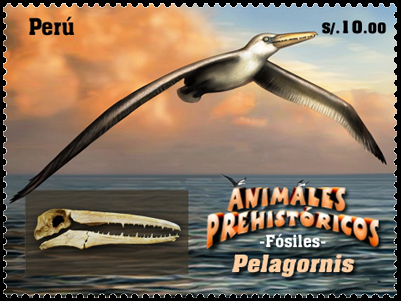Pelagornis sandersi Ksepka, 2014

(Da: fr.wikipedia.org)
Phylum: Chordata Haeckel, 1874
Subphylum: Vertebrata Cuvier, 1812
Classe: Aves Linnaeus, 1758
Ordine: Pelecaniformes harpe, 1891
Famiglia: Pelagornithidae Fürbringer, 1888
Genere: Pelagornis Lartet, 1857
Specie e sottospecie
Il genere annovera attualmente le seguenti specie: Pelagornis chilensis Mayr & Rubilar, 2010 - Pelagornis mauretanicus Mourer-Chauviré & Geraads, 2008 - Pelagornis miocaenus Lartet, 1857 - Pelagornis sandersi Ksepka, 2014.
Descrizione
È stato stimato che la loro apertura alare fosse compresa fra 6,1 e 7,4 metri, il che farebbe del Pelagornis sandersi l'uccello più grande finora scoperto, con un'apertura alare doppia rispetto all'attuale uccello vivente: l'albatro urlatore. È stato inoltre stimato che potesse raggiungere una velocità massima di 60 km/h. Taluni scienziati sono rimasti sorpresi dal fatto che potesse volare, dato che il suo peso (compreso fra i 22 e i 40 kg) non avrebbe dovuto consentigli di volare secondo la teoria predominante sul meccanismo di volo degli uccelli. Secondo lo scopritore Dan Ksepka, del National Evolutionary Synthesis Center di Durham, sarebbe stato in grado di volare grazie al suo corpo relativamente piccolo rispetto alla dimensione delle ali e grazie alle forti correnti aeree oceaniche.
Diffusione
Vissuto tra 25 e 28 milioni di anni fa, i suoi resti fossili sono stati scoperti in sedimenti dell'Eocene: Formazione arida (Bartoniano), Marocco - Formazione La Meseta , Isola Seymour, Antartide. Oligocene: Formazione del ponte Chandler, Carolina del Sud. Miocene: Arenaria di Black Rock, Australia - Formazione Bahía Inglesa (Mayoan - Montehermosan), Cile - Formazione di Molasse Coquilliere, Francia - Formazione Calvert, Virginia - Foce del fiume Waipara (Waiauan), Canterbury, Nuova Zelanda - Formazione Pisco (Chasicoano - Huayqueriano), Perù - Costa da Caparica o Fonte de Pipa, bacino del Tago, Portogallo - Formazioni Castillo (Colhuehuapian - Santacrucian) e Capadare (Laventan - Mayoan), Venezuela. Pliocene: Formazione Greta, Nuova Zelanda - Formazione Purisima , California e Formazione Yorktown, Carolina del Nord. Pleistocene inferiore: Ahl al Oughlam, Marocco.
Bibliografia
–Bourdon, Estelle (2005). "Osteological evidence for sister group relationship between pseudo-toothed birds (Aves: Odontopterygiformes) and waterfowls (Anseriformes)". Naturwissenschaften. 92 (12): 586-91.
–Brodkorb, Pierce (1963). "Catalogue of fossil birds. Part 1 (Archaeopterygiformes through Ardeiformes)". Bulletin of the Florida State Museum, Biological Sciences. 7 (4): 179-293.
–Chávez, Martín; Stucchi, Marcelo & Urbina, Mario (2007): El registro de Pelagornithidae (Aves: Pelecaniformes) y la Avifauna Neógena del Pacífico Sudeste [The record of Pelagornithidae (Aves: Pelecaniformes) and the Neogene avifauna of the southeast Pacific]. Bulletin de l’Institut Français d’Études Andines 36(2): 175-197 [Spanish with French and English abstracts]. PDF fulltext.
–Goedert, James L. (1989). "Giant Late Eocene Marine Birds (Pelecaniformes: Pelagornithidae) from Northwestern Oregon". Journal of Paleontology. 63 (6): 939-944.
–Hopson, James A. (1964). "Pseudodontornis and other large marine birds from the Miocene of South Carolina". Postilla. 83: 1-19.
–Lanham, Urless N. (1947). "Notes on the phylogeny of the Pelecaniformes" (PDF). Auk. 64 (1): 65-70.
–Mayr, Gerald (2008). "A Skull of the Giant Bony-Toothed Birddasornis(Aves: Pelagornithidae) from the Lower Eocene of the Isle of Sheppey". Palaeontology. 51 (5): 1107-1116.
–Mayr, Gerald (2009): Paleogene Fossil Birds. Springer-Verlag, Heidelberg & New York.
–Mayr, Gerald; Hazevoet, Cornelis J.; Dantas, Pedro & Cachao, Mário (2008). "A sternum of a very large bony-toothed bird (Pelagornithidae) from the Miocene of Portugal". Journal of Vertebrate Paleontology. 28 (3): 762-769.
–Mayr, Gerald & Rubilar-Rogers, David (2010). "Osteology of a new giant bony-toothed bird from the Miocene of Chile, with a revision of the taxonomy of Neogene Pelagornithidae". Journal of Vertebrate Paleontology. 30 (5): 1313-1330.
–Mlíkovský, Jirí (2002): Cenozoic Birds of the World, Part 1: Europe. Ninox Press, Prague.
–Mlíkovský, Jirí (2009). "Evolution of the Cenozoic marine avifaunas of Europe" (PDF). Annalen des Naturhistorischen Museums in Wien A. 111: 357–374.
–NASA Earth Observatory (NEO) (2008): Panama: Isthmus that Changed the World.
–National Museum of Natural History Department of Paleobiology (NMNH-DP) [2009]: Paleobiology Collections Search.
–Olson, Storrs L. (1985): The Fossil Record of Birds. In: Farner, D. S.; King, J. R. & Parkes, Kenneth C. (eds.): Avian Biology 8: 79-252.
–Rasmussen, Pamela C. (1998). "Early Miocene Avifauna from the Pollack Farm Site, Delaware" (PDF). Delaware Geological Survey Special Publication. 21: 149-151.
–Rincón R., Ascanio D. & Stucchi, Marcelo (2003): Primer registro de la familia Pelagornithidae (Aves: Pelecaniformes) para Venezuela [First record of Pelagornithidae family from Venezuela]. Boletín de la Sociedad Venezolana de Espeleología 37: 27-30 [Spanish with English abstract]. PDF fulltext.
–Scarlett, R. J. (1972). "Bone of a presumed odontopterygian bird from the Miocene of New Zealand". New Zealand Journal of Geology and Geophysics. 15 (2): 269-274.
–Walsh, Stig A. (2000): Big-chested birds – exciting new avian material from the Neogene of Chile. Talk held at the 48th Annual Symposium of Vertebrate Palaeontology and Comparative Anatomy, 1 September 2000, Portsmouth, UK.
–Walsh, Stig A. & Hume, Julian P. (2001). "A new Neogene marine avian assemblage from north-central Chile" (PDF). Journal of Vertebrate Paleontology. 21 (3): 484-491.

|
Data: 01/01/2016
Emissione: Animali preistorici Stato: Perù |
|---|